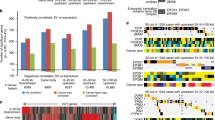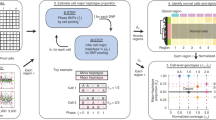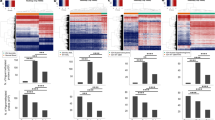Abstract
Aberrant methylation of CpG islands and genomic deletion are two predominant mechanisms of gene inactivation in tumorigenesis, but the extent to which they interact is largely unknown. The lack of an integrated approach to study these mechanisms has limited the understanding of tumor genomes and cancer genes. Restriction landmark genomic scanning (RLGS; ref. 1) is useful for global analysis of aberrant methylation of CpG islands, but has not been amenable to alignment with deletion maps because the identity of most RLGS fragments is unknown. Here, we determined the nucleotide sequence and exact chromosomal position of RLGS fragments throughout the genome using the whole chromosome of origin of the fragments2 and in silico restriction digestion of the human genome sequence. To study the interaction of these gene-inactivation mechanisms in primary brain tumors, we integrated RLGS-based methylation analysis with high-resolution deletion maps from microarray-based comparative genomic hybridization (array CGH; ref. 3). Certain subsets of gene-associated CpG islands were preferentially affected by convergent methylation and deletion, including genes that exhibit tumor-suppressor activity, such as CISH1 (encoding SOCS1; ref. 4), as well as genes such as COE3 that have been missed by traditional non-integrated approaches. Our results show that most aberrant methylation events are focal and independent of deletions, and the rare convergence of these mechanisms can pinpoint biallelic gene inactivation without the use of positional cloning.
This is a preview of subscription content, access via your institution
Access options
Subscribe to this journal
Receive 12 print issues and online access
$209.00 per year
only $17.42 per issue
Buy this article
- Purchase on Springer Link
- Instant access to full article PDF
Prices may be subject to local taxes which are calculated during checkout




Similar content being viewed by others
References
Hatada, I., Hayashizaki, Y., Hirotsune, S., Komatsubara, H. & Mukai, T. A genomic scanning method for higher organisms using restriction sites as landmarks. Proc. Natl Acad. Sci. USA 88, 9523–9527 (1991).
Yoshikawa, H. et al. Chromosomal assignment of human genomic NotI restriction fragments in a two-dimensional electrophoresis profile. Genomics 31, 28–35 (1996).
Snijders, A.M. et al. Assembly of microarrays for genome-wide measurement of DNA copy number. Nat. Genet. 29, 263–264 (2001).
Yoshikawa, H. et al. SOCS-1, a negative regulator of the JAK/STAT pathway, is silenced by methylation in human hepatocellular carcinoma and shows growth-suppression activity. Nat. Genet. 28, 29–35 (2001).
Makos, M. et al. Distinct hypermethylation patterns occur at altered chromosome loci in human lung and colon cancer. Proc. Natl Acad. Sci. USA 89, 1929–1933 (1992).
Herman, J.G. et al. Silencing of the VHL tumor-suppressor gene by DNA methylation in renal carcinoma. Proc. Natl Acad. Sci. USA 91, 9700–9704 (1994).
Jain, A.J. et al. Fully automatic quantification of microarray image data. Genome Res. 12, 325–332 (2002).
Ginzinger, D.G. et al. Measurement of DNA copy number at microsatellite loci using quantitative PCR analysis. Cancer Res. 60, 5405–5409 (2000).
Costello, J.F. et al. Aberrant CpG-island methylation has non-random and tumor-type-specific patterns. Nat. Genet. 24, 132–138 (2000).
Rush, L.J. et al. Novel methylation targets in de novo acute myeloid leukemia with prevalence of chromosome 11 loci. Blood 97, 3226–3233 (2001).
Smiraglia, D.J. et al. Excessive CpG island hypermethylation in cancer cell lines versus primary human malignancies. Hum. Mol. Genet. 10, 1413–1419 (2001).
Fruhwald, M.C. et al. Aberrant promoter methylation of previously unidentified target genes is a common abnormality in medulloblastomas—implications for tumor biology and potential clinical utility. Oncogene 20, 5033–5042 (2001).
Dai, Z.Y. et al. Global methylation profiling of lung cancer identifies novel methylated genes. Neoplasia 3, 314–323 (2001).
Rouillard, J.M. et al. Virtual genome scan: a tool for restriction landmark-based scanning of the human genome. Genome Res. 11, 1453–1459 (2001).
Starr, R. et al. A family of cytokine-inducible inhibitors of signalling. Nature 387, 917–921 (1997).
Endo, T.A. et al. A new protein containing an SH2 domain that inhibits JAK kinases. Nature 387, 921–924 (1997).
Mohapatra, G. et al. Genetic analysis of glioblastoma multiforme provides evidence for subgroups within the grade. Genes Chromosomes Cancer 21, 195–206 (1998).
Fults, D. & Pedone, C. Deletion mapping of the long arm of chromosome 10 in glioblastoma multiforme. Genes Chromosomes Cancer 7, 173–177 (1993).
Karlbom, A.E. et al. Loss of heterozygosity in malignant gliomas involves at least three distinct regions on chromosome 10. Hum. Genet. 92, 169–174 (1993).
von Deimling, A. et al. Comprehensive allelotype and genetic analysis of 466 human nervous system tumors. J. Neuropathol. Exp. Neurol. 59, 544–558 (2000).
Dubois, L. & Vincent, A. The COE—Collier/Olf1/EBF—transcription factors: structural conservation and diversity of developmental functions. Mech. Dev. 108, 3–12 (2001).
Acknowledgements
We thank the University of California, San Francisco Neurosurgery Tumor Bank for tissue samples, J. Melki for advice on bisulfite sequencing and R. Pieper for critical review of the manuscript. This work was supported by grants from the James S. McDonnell Foundation and the US National Institutes of Health.
Author information
Authors and Affiliations
Corresponding author
Ethics declarations
Competing interests
The authors declare no competing financial interests.
Supplementary information
Rights and permissions
About this article
Cite this article
Zardo, G., Tiirikainen, M., Hong, C. et al. Integrated genomic and epigenomic analyses pinpoint biallelic gene inactivation in tumors. Nat Genet 32, 453–458 (2002). https://doi.org/10.1038/ng1007
Received:
Accepted:
Published:
Issue Date:
DOI: https://doi.org/10.1038/ng1007
This article is cited by
-
Genome-wide promoter DNA methylation profiling of hepatocellular carcinomas arising either spontaneously or due to chronic exposure to Ginkgo biloba extract (GBE) in B6C3F1/N mice
Archives of Toxicology (2019)
-
Regulation of MET receptor tyrosine kinase signaling by suppressor of cytokine signaling 1 in hepatocellular carcinoma
Oncogene (2015)
-
Ebf factors and MyoD cooperate to regulate muscle relaxation via Atp2a1
Nature Communications (2014)
-
Mild folate deficiency induces genetic and epigenetic instability and phenotype changes in prostate cancer cells
BMC Biology (2010)



